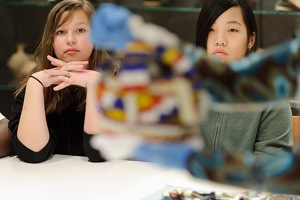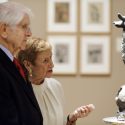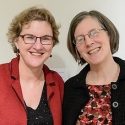Chazen plays key role in African art project in Madison schools
For Susan Curtis, a retired school nurse, art appreciation is not just academic.
She knows that art also has the power to break down cultural barriers and stereotypes, inspire creativity, and foster community. With Africa Connects!, a K-12 art history and service-learning project in Madison, Curtis puts that idea into practice.
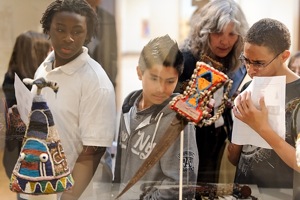
Children from Sherman Middle School take notes while viewing African art and beaded works on exhibit at the Chazen Museum of Art. The group is participating in a grant-funded project — called “Africa Connects!” — led by volunteer coordinator Susan Curtis (background at right) and offered through the Madison Metropolitan School District.
Photo: Jeff Miller
With help from the Chazen Museum of Art and others in the community, Curtis worked to forge a partnership between local schools that opened the door for high school and middle school students to learn more about African art.
The project will culminate later this month with an art exhibit with works produced by Sherman Middle School and Shabazz High School students and curated by the high school students.
“Unless a youthful and diverse audience is cultivated, I wonder whether there will be a place outside a computer monitor for future generations to see artwork or live performances,” Curtis says, noting the importance of raising awareness of African culture and art.
Curtis credits a great teacher for sparking her interest in African art in college. As she delved into the subject she admired the artistry and skill, but was also moved by the spiritual and ritual importance of the objects in African societies. She began her 21-year nursing career with a master’s degree in art history in hand.
About 10 years ago, while working at Madison’s Shabazz High School, Curtis was invited to lecture about African art history by art teacher Martha Vasquez, who had learned of her degree.
It was the beginning of a long collaboration.
Renewing her academic interest in African art, Curtis forged ties with University of Wisconsin–Madison professors and the Chazen Museum of Art. She registered as a university special student and took classes for credit from professors Freida High, Henry Drewal, and Jill Casid.
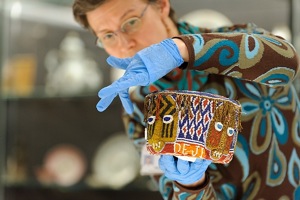
Maria Saffioti Dale, academic curator at the Chazen Museum of Art, introduces children from Sherman Middle School to African art and beaded works in the museum’s Objects Study room.
Photo: Jeff Miller
In 2010 Curtis took professor Drewal’s museum studies class, which included guest presentations by Chazen staff, and she became more interested in museum outreach. The Chazen is a visitor destination, yet as part of the university it also has an educational mission. Its collection is utilized by art and art history students as well as the horticulture, nursing, and other departments across campus.
Inspired, Curtis proposed an art history and service-learning project for the two schools where she had worked for many years.
With the Chazen’s African art as a focal point, she wanted to “teach youth how African values are transmitted by visual arts, comparing ways American values are signaled by visual symbols, . . . to break down negative responses to cultural differences.”
The Chazen’s involvement in the project is an extension of its work with K-12 art curricula in many area schools. Classes regularly tour the museum and the museum’s education department develops teaching materials for schools.
With Madison Metropolitan School District mini-grant funding from the Evjue Foundation and the Foundation for Madison Public Schools, Curtis implemented Africa Connects! Shabazz students signed up for a full-quarter class, “African Beadwork,” to learn about South African and Nigerian beadwork styles and create artwork inspired by these traditions. Sherman students would spend nine classes on the project.
The Chazen has a notable collection of Yorúbà beaded regalia, offering outstanding craftsmanship and cultural significance. Beads, color, and pattern communicate sophisticated social, religious, and political ideas in many parts of Africa.
Comparing Yorúbà and Western color theory or the role of iconic visual elements can reveal a lot about both traditions. Drawing connections between cultural artifacts, from a British crown to a bridal veil to an African priest’s coronet, shows students how traditional symbols may travel and be adapted around the world.
After lessons in their classrooms, the Shabazz and Sherman students visited the newly expanded Chazen, which has a dedicated African art gallery as well as an object study room that allows for closer examination of artworks and interaction with curators and teachers.
In the African gallery, the students identified symbols and patterns and noted their favorite pieces.
They took a brief tour with a trained docent, then gathered in the museum’s study room with Maria Saffiotti Dale, a museum curator, and Marguerite Hecksher, a doctoral candidate in African art history, for an interactive show-and-tell with several additional pieces.
Curtis says the Shabazz class was fascinated to learn about specialization — for instance, curators do not clean artwork, that task is left to a conservator.
The students had a range of reactions to the project.
“I like the beading class because I’m not very good at painting or drawing, but I like art, so this class has helped me find my niche,” says Ava, a Shabazz student.
Kea, another student, added, “I like working ‘hands on’ and learning about other cultures through art. An aspect of art that I appreciate is finding myself and who I am.”
And Nick responded, “I’ve learned that there are lots of factors that go into African art work, based on their different societies and cultures.”
The students are now devoting several weeks to making beaded art. The high school students will share their pieces and talk with the middle school students, who will then follow this service-learning model and take their own beadwork to talk about African art with fifth graders.
To wrap up the project, the Shabazz students will curate and mount an exhibition of all the finished student artwork, to be on display at Warner Park Community Center from March 20-22.
Madison Metropolitan School District mini-grants support projects outside the scope of the budgeted school curriculum.
For Africa Connects! the grant covers materials for several hundred students as well as buses and substitute teachers for the field trips.
Curtis’s project is intensive, yet with a developed curriculum and funding, the model can be used in any school and is adaptable for studying other cultures.
For instance, the Chazen has subcollections of Asian, Native American, Hispanic, and European artworks that could be utilized for similar projects. Curtis hopes to receive another grant and refine the project next year, and with her renewed passion for art history will also pursue her Ph.D. from UW–Madison in the fall.
Subscribe to Wisconsin Ideas
Want more stories of the Wisconsin Idea in action? Sign-up for our monthly e-newsletter highlighting how Badgers are taking their education and research beyond the boundaries of the classroom to improve lives.

